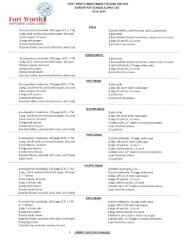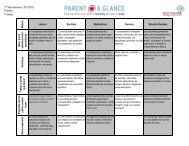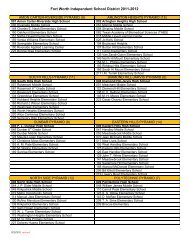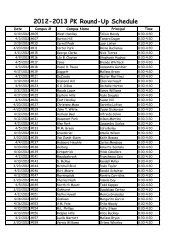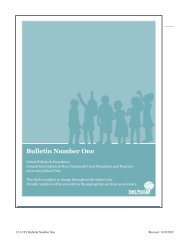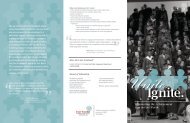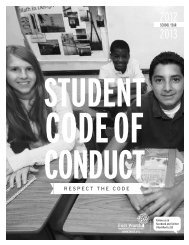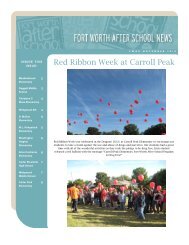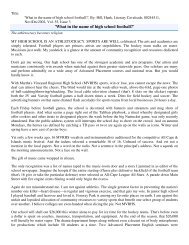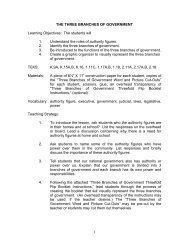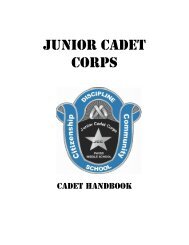COLUMBUS DAY By Kathy Aldridge Learning Objective(s): The ...
COLUMBUS DAY By Kathy Aldridge Learning Objective(s): The ...
COLUMBUS DAY By Kathy Aldridge Learning Objective(s): The ...
Create successful ePaper yourself
Turn your PDF publications into a flip-book with our unique Google optimized e-Paper software.
<strong>COLUMBUS</strong> <strong>DAY</strong><br />
<strong>By</strong> <strong>Kathy</strong> <strong>Aldridge</strong><br />
<strong>Learning</strong> <strong>Objective</strong>(s): <strong>The</strong> students will:<br />
1. Explain the significance of Columbus Day.<br />
2. Understand some of the events and accomplishments associated<br />
with Christopher Columbus.<br />
3. Obtain information about Christopher Columbus by singing a song.<br />
4. Become familiar with the four cardinal directions.<br />
TEKS: SS K.1, K.15, 1.2A, 1.4A, 1.17A,C, 2.5A, 2.17A,D<br />
Materials Needed: A large classroom world map or overhead transparency of a<br />
world map, a children’s literature book about the voyage of<br />
Christopher Columbus such as In 1492 by Jean Marzollo, an<br />
8” x 11” paper copy of a world map showing the continents<br />
of Europe, Africa, Asia, Australia, and Antarctica only<br />
Vocabulary: continent, Europeans, explorer, map, ocean, voyage<br />
Teaching Strategy:<br />
1. Introduce the lesson by telling students that people who search for<br />
or investigate new places are called explorers. Ask students if they<br />
have ever searched or investigated a new place. Have them relate<br />
their exploration experiences. Ask them why they like to explore.<br />
2. Explain to students that Columbus Day is celebrated the second<br />
Monday in October in the United States to honor a great explorer<br />
from the past, Christopher Columbus. Ask students to share<br />
anything they know about him.<br />
3. Show students a classroom size map of the world with North and<br />
South America covered up. (<strong>The</strong> teacher may prefer to use an<br />
overhead transparency of a map of the world exposing all of the<br />
continents except North and South America.) Tell students that this<br />
map represents the world, as Europeans knew it, during Columbus’<br />
time, over 500 years ago. Emphasize that the United States of<br />
America did not even exist then.<br />
4. Indicate the continent of Europe on the large map/overhead. Draw<br />
a compass on the board and explain how it is used. Ask students<br />
what direction Asia is from Europe. Tell students that Europeans<br />
wanted to travel to the Indies (Asia) for gold and spices. Ask them<br />
to look at the map, figure out different ways Europeans could travel
Evaluation:<br />
to the Indies by land or water, and share their ideas with the class.<br />
5. Explain that Columbus wanted to discover a western route to the<br />
Indies (Asia). To illustrate this principle, the teacher should bend<br />
the sides of the paper copy of the world map, which doesn’t include<br />
North and South America, backwards until the sides touch. Forming<br />
this tube by simulating a globe should enable students to see why<br />
Columbus thought he could reach the Indies (Asia) by going west.<br />
6. Share that Columbus asked King John II of Portugal to sponsor his<br />
voyage, but was turned down. Columbus then asked for support<br />
from Queen Isabella and King Ferdinand of Spain. After being<br />
rejected several times over quite a few years, Columbus finally<br />
received the support of the King and Queen of Spain. Indicate the<br />
country of Spain on the large map/overhead.<br />
7. Using an appropriate children’s literature book about Columbus,<br />
read students a story about the historic voyage. Point out that<br />
Columbus kept a log about each day of the voyage, so that is how<br />
we know what happened.<br />
8. After students are told that Columbus discovered a “New World,”<br />
reveal that his discovery was somewhere in the Bahamas, instead<br />
of the Indies. Uncover the continents of North and South America<br />
on the large world map/overhead. Indicate the location of the<br />
Bahama Islands. Trace the route Columbus took from Spain to the<br />
Bahamas and point out how it was logical for Columbus to assume<br />
he had reached Asia.<br />
9. Explain that though Columbus didn’t reach the Indies, the Bahamas<br />
still had riches that Columbus could take back to Spain. Columbus<br />
made three additional voyages to the Bahamas and many other<br />
Europeans sailed there, too. Columbus even took horses to the<br />
new world on his second voyage.<br />
10. Tell students Columbus Day is a holiday celebrated in the United<br />
State to celebrate Columbus’ voyage from Spain to this new<br />
land/world in the west.<br />
11. Teach students the song “Christopher Columbus” on the next page.<br />
Assign each student a verse from the song to illustrate with a picture.<br />
Duplicate complete sets of the pictures for each verse, and have students,<br />
working in groups, put the pictures in sequential order.
Created by <strong>Kathy</strong> <strong>Aldridge</strong>, Elementary Consultant, Law-Related Education, State Bar of Texas, 2003.<br />
Christopher Columbus<br />
(Sung to the tune of Frere Jacques or Are You Sleeping?)<br />
Teacher: Christopher Columbus<br />
Children: Christopher Columbus<br />
Teacher: Wanted to explore.<br />
Children: Wanted to explore.<br />
Teacher: He crossed the Atlantic Ocean<br />
Children: He crossed the Atlantic Ocean<br />
Teacher: In 1492<br />
Children: In 1492.<br />
Teacher: He took 90 men<br />
Children: He took 90 men<br />
Teacher: On 3 Spanish ships;<br />
Children: On 3 Spanish ships;<br />
Teacher: <strong>The</strong> Nina and the Piñta<br />
Children: <strong>The</strong> Nina and the Piñta<br />
Teacher: And Santa Maria.<br />
Children: And Santa Maria.<br />
Teacher: <strong>The</strong>y sailed for 2 months.<br />
Children: <strong>The</strong>y sailed for 2 months.<br />
Teacher: <strong>The</strong> crew was getting tired,<br />
Children: <strong>The</strong> crew was getting tired,<br />
Teacher: But on October 12 th ,<br />
Children: But on October 12 th ,<br />
Teacher: <strong>The</strong>y finally saw land.<br />
Children: <strong>The</strong>y finally saw land.<br />
Teacher: Columbus thought it was the Indies.<br />
Children: He thought it was the Indies.<br />
Teacher: But he was wrong.<br />
Children: But he was wrong.<br />
Teacher: He landed in the Bahamas.<br />
Children: Landed in the Bahamas.<br />
Teacher: He’d found a new land.<br />
Children: He’d found a new land.
Teacher: He met American Indians.<br />
Children: He met American Indians.<br />
Teacher: <strong>The</strong>y traded many things.<br />
Children: <strong>The</strong>y traded many things.<br />
Teacher: He made the voyage again,<br />
Children: He made the voyage again,<br />
Teacher: Again and again.<br />
Children: Again and again.<br />
Teacher: Christopher Columbus<br />
Children: Christopher Columbus<br />
Teacher: Discovered a “New World.”<br />
Children: Discovered a ‘New World.”<br />
Teacher: This is why we honor him<br />
Children: This is why we honor him<br />
Teacher: On Columbus Day.<br />
Children: On Columbus Day.





